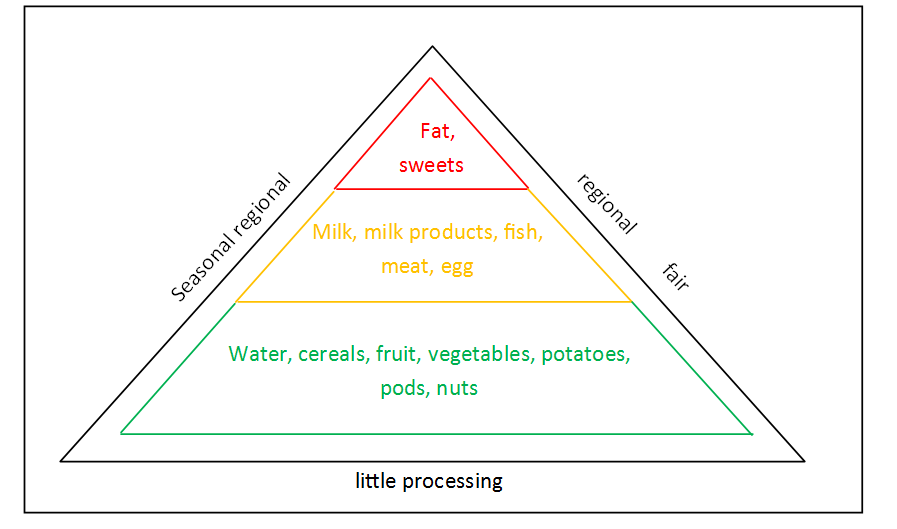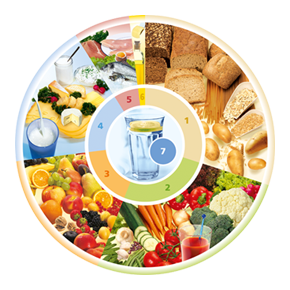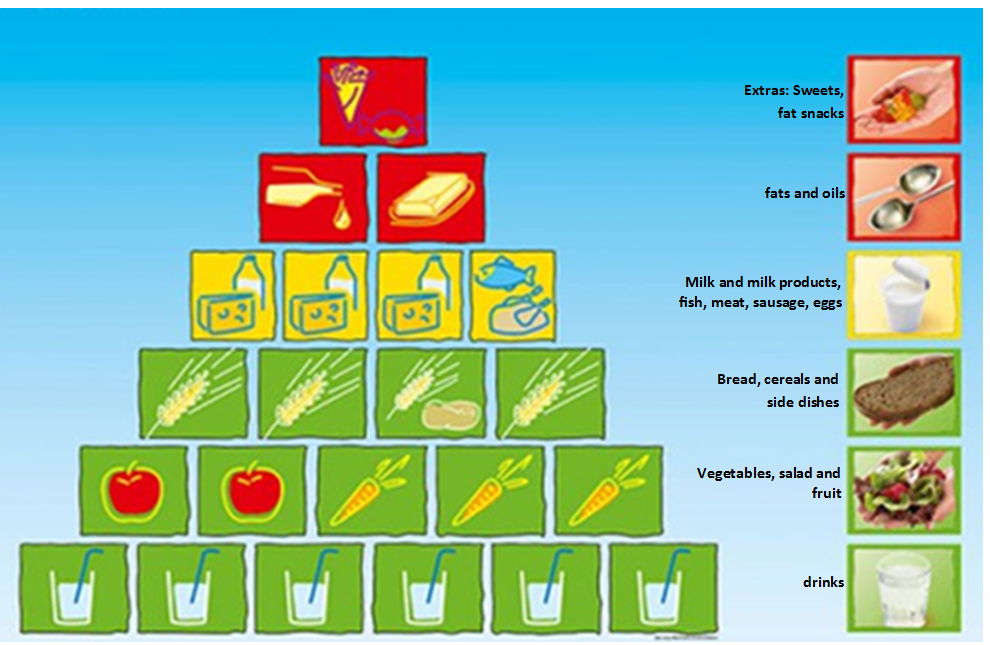Chapter 2 – Food selection for adolescent
The rules of thumb for the consumption of food are:
- plenty of water or other unsweetened drinks
- every day vegetables, fruit, cereals and cereal products and/or potatoes
- animal products such as meat, sausage, fish, eggs, but also milk and milk products such as cheese, curd, yoghurt only in moderation
- sparingly with: salt, sugar, sweets, snack products and fatty foods. This is especially true for fat-rich products with a high content of saturated fatty acids, such as, for example, chocolate, chips, flips and the like
The following nutritional pyramid is complemented by aspects of sustainability. It provides food from the region or from fair trade, organic & seasonal food as well as a low processing (as fresh raw materials as possible). Taking these aspects into consideration, it is also possible to incorporate other decision-making criteria in the selection of food in addition to the nutritional values. More detailed information can be found in Unit 3.

Source: www.biofuerkinder.de/agrar/wp-content/uploads/2013/02/Bio-in-der-Krippe.pdf
Balanced food and drink - so it goes! The nutritional circle in Detail
In order to provide us with all essential nutrients, a great variety is required. The diet should therefore be as diverse as possible. However, it is not just the choice of food, but the quantity also plays an important role.
The DGE nutritional circle subdivides the rich food supply into seven groups represented by a segment in the circle. The different sizes of the segments illustrate the extent to which the different food groups should be represented in a full-fledged diet. The larger a segment of the circle, the larger amounts should be consumed from this food group. Food out of the small segments should be used sparingly.

Source: http://www.dge.de/ernaehrungspraxis/vollwertige-ernaehrung/ernaehrungskreis
Drinks are the largest food group with a daily drinking volume of around 1.5 liters. Then follow the plant foods grain, cereal products, potatoes, vegetables as well as fruit. They form the basis of a full-fledged diet and supply carbohydrates, abundant vitamins, minerals, dietary fiber as well as secondary plant products. Animal products supplement the daily food plan in small portions and should be as low in fat as possible. They provide the body with high-quality protein (protein), vitamins and minerals. Fat and fat-rich foods should be consumed rather rarely. The quality plays a decisive role here, because vegetable oils mainly supply the essential fatty acids.
Whoever selects from all seven food groups, takes account of the quantity ratio shown and uses the food diversity of the individual food groups, creates the best conditions for a full-fledged diet.
Educational work with the food pyramid
For the pedagogical work with children, it has proved to be a good idea to change the nutritional pyramid into the food pyramid. The AID information service from Germany has developed many games around the nutritional pyramid and educational material, which are currently provided by the Federal Center for Nutrition (http://shop.aid.de/bundeszentrum-fuer-ernaehrung). The amounts of food are shown in the pyramid as individual fields. Each field is a portion of each food. As an orientation, one assumes that a handful of the respective food should be consumed. Since a child's hand is smaller than the hand of an adult, the amounts match the calorie requirement. So, you should eat 2 hands full of fruit and 3 hands full of vegetables daily.

Source: http://shop.aid.de/3923/die-aid-ernaehrungspyramide-din-a5-karten-im-10er-pack
|
Amounts |
Food Group |
|
6 servings |
Drinks, at least one serving to each meal and in between |
|
5 servings |
Whole meal bread, side dishes such as oven potatoes, whole grain noodles or natural rice, cereals (also as muesli) |
|
5 servings |
Fruit, vegetables, legumes, lettuce and raw food (5 a day) |
|
3 servings |
milk and milk products |
|
1 serving |
2-3 times per week Meat and sausage (lean versions) 1-2 times per week Fish, 2-3 times egg (also in processed form) |
|
2 servings |
Vegetable oils and spreadable fat |
|
1 serving |
10% of the daily requirement Sweets, biscuits, salty snacks, sugar sweetened drinks, fat food (fries, croissants) - this is a recommendation and not a must! |



